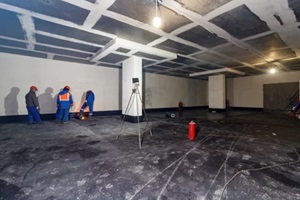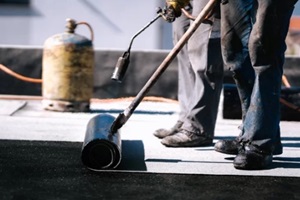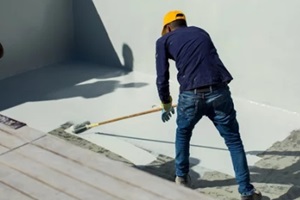 Quality waterproofing is essential for commercial buildings in Delaware. With high humidity, tons of rainfall, and the occasional hurricane, good waterproofing helps maintain structural stability and prevent moisture damage. To keep buildings safe and preserved, Delaware has strict waterproofing rules for commercial spaces in their Administrative Code.
Quality waterproofing is essential for commercial buildings in Delaware. With high humidity, tons of rainfall, and the occasional hurricane, good waterproofing helps maintain structural stability and prevent moisture damage. To keep buildings safe and preserved, Delaware has strict waterproofing rules for commercial spaces in their Administrative Code.
Understanding these regulations is important for construction crews, contractors, building owners, and managers to stay compliant.
This article will break down key parts of Delaware’s waterproofing rules, focusing on important requirements and practical tips to follow for commercial projects.
Why Waterproofing Matters in Delaware
Delaware’s moderate temperatures year-round, coastal climate, and high groundwater mean more risk for mold, mildew, and excess moisture without proper waterproofing. In commercial spaces, inadequate waterproofing can eventually cause structural problems, indoor air quality issues, slip hazards, equipment damage, and even electrical fires.
Common weak spots include foundations, below-grade walls, slab joints, tunnels, rooftops, and plazas. For high rises, water getting through facades, windows, mechanical floors, and podiums poses significant risks, too. Good waterproofing is the first line of defense against these vulnerabilities.
Understanding Waterproofing Membrane Standards
Delaware defines a waterproofing membrane as “a clear or opaque coating labeled and designed to apply on concrete and masonry to provide a seamless waterproofing layer preventing liquid water from getting into the substrate.”
These coatings need a minimum 25 mil (0.025 inch) dry film thickness for commercial use. They also must meet or exceed the ASTM International standard ASTM C836-06. This standard covers exterior waterproofing materials and methods for below-grade applications.
These tight standards ensure quality and durability for waterproofing jobs. For instance, the 25 mil thickness helps plaza deck coatings withstand foot traffic without compromise. Likewise, meeting ASTM C836-06 means below-grade waterproofing for multi-story parking garages and warehouses will resist hydrostatic pressure for decades.
VOC Rules for Waterproofing
On top of membrane requirements, Delaware’s regulations limit the volatile organic compounds (VOCs) permissible in various waterproofing-related coatings and sealants. VOCs are carbon-based chemicals that can quickly and easily evaporate at standard room temperature and are usually released as gases from solvents, paints, and varnishes.
 In commercial spaces, too many VOCs hurt indoor air quality and can harm occupant health. Delaware’s VOC rules balance air quality and building preservation. The allowable VOC levels determine which waterproofing products can be used where.
In commercial spaces, too many VOCs hurt indoor air quality and can harm occupant health. Delaware’s VOC rules balance air quality and building preservation. The allowable VOC levels determine which waterproofing products can be used where.
Acrylic and polyurethane coatings are some lower-VOC options that work better for indoor concrete sealing. At the same time, higher-VOC epoxy and bitumen solutions are acceptable for outdoor parking structures and structural waterproofing.
The Testing Standards for Compliance
To prove they’re following the rules, Delaware references several ASTM International standards related to essential waterproofing material performance:
- ASTM C67-07, ASTM C97-02, ASTM C140-06: Testing water repellency
- ASTM E96/E96M-05: Testing water vapor transmission rates
- ASTM D3273-00 and ASTM D3274-95: Testing mold/mildew resistance
- ASTM D4585-99 and ASTM D714-02: Testing blister resistance
These test methods confirm claims about waterproofing products’ water-repelling abilities, breathability, durability under hydrostatic pressure, and resilience against fungi and microbes – all essential in Delaware’s damp climate.
Under the regulations, manufacturers need quality control and testing data available if Delaware’s Department of Natural Resources and Environmental Control requests it. Likewise, contractors and applicators should collect this documentation to prove compliance.
Achieving and Staying Compliant with Delaware’s Rules
Following Delaware’s commercial waterproofing regulations doesn’t have to be difficult. Consider the following to make your life easier:
Start early when planning new construction or renovations. First, consult with a waterproofing specialist to select suitable products for each application area based on VOC composition limits and required performance attributes. Doing your homework early ensures the right materials for the space.
Do your due diligence to verify products meet regulations. Explicitly request VOC emission datasheets and ASTM standard compliance reports from all waterproofing material manufacturers, whether for membranes, sealants, or protective coatings. Collect this documentation upfront to prove adherence.
Keep meticulous records of all products used, noting VOC levels, application coverage rates per square foot, total square footage treated, application method specifics, and any other relevant data points. Maintaining organized, detailed files not only aids your process management but also provides necessary information if regulatory agencies request evidence of compliance.
Strictly adhere to manufacturer application instructions during installation, setup, curing times, and beyond. Following guidance precisely ensures installed materials meet the same standards as when tested in a controlled environment, delivering expected performance and longevity.
Schedule periodic maintenance checks, assessments, and waterproofing reapplications per the manufacturer’s recommendations. Built-in reminders to inspect performance over time and refresh protective layers as needed are necessary for sustained regulatory conformance and safe, resilient buildings.
The Exceptions and Special Cases
While getting Delaware’s main waterproofing rules is key, there are also some noteworthy exceptions and unique use cases:
 Coatings made strictly for out-of-state use don’t have to meet VOC limits. But in-state sales still require compliance even if manufacturing happens elsewhere.
Coatings made strictly for out-of-state use don’t have to meet VOC limits. But in-state sales still require compliance even if manufacturing happens elsewhere.- Waterproofing products sold in containers of less than one liter aren’t subject to VOC restrictions. But bundling small containers to meet demand doesn’t qualify for exemption.
- EPA/Dept. of Agriculture registered marine antifouling coatings have special composition allowances to prevent marine growth, but VOC thresholds still apply.
Ensure Compliance with Delaware Commercial Waterproofing Regulations with Help from Waterproof Caulking & Restoration
Dealing with Delaware’s complex commercial waterproofing regulations can be challenging, so having an experienced partner is key for long-term compliance and building preservation. Waterproof Caulking & Restoration has offered invaluable expertise to our clients for many years, helping them implement robust waterproofing solutions for their commercial structures across the state.
Contact us today at 484.265.9646 or schedule a consultation online. Our OSHA-certified technicians will help you design and implement waterproofing solutions that fully comply with Delaware commercial waterproofing regulations.
